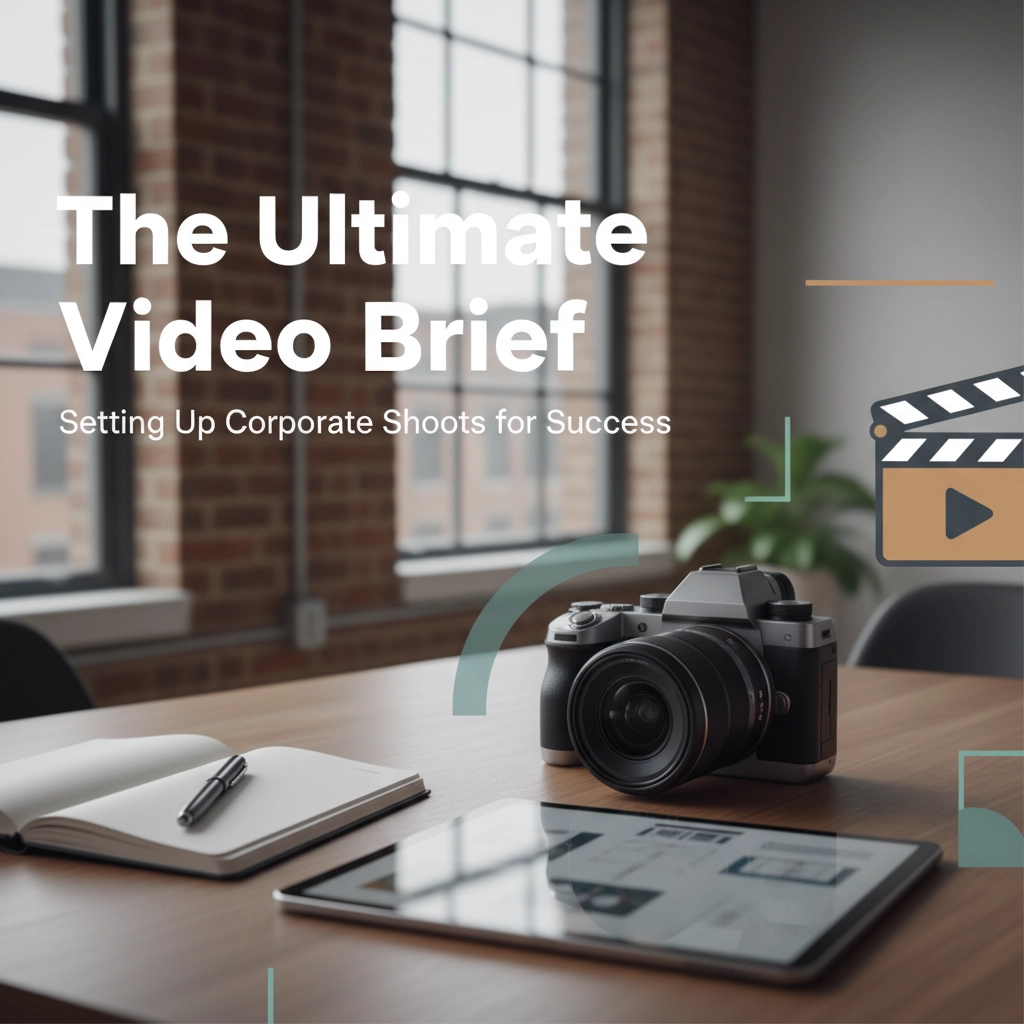The Ultimate Video Brief: Setting Up Corporate Shoots for Success

Here's the truth: most corporate video projects crash and burn before the cameras even start rolling. Not because of bad equipment or terrible weather, but because nobody took the time to create a proper video brief. It's like trying to build a house without blueprints. Sure, you might end up with something that looks like a house, but good luck explaining why the bathroom is in the kitchen.
A solid video brief isn't just a nice-to-have document that sits in someone's email folder. It's your north star, your roadmap, and honestly? Your best friend when things start going sideways on set (and trust me, they will). Let's dive into how to create video briefs that actually work and set up shoots that deliver results instead of headaches.
Why Your Video Brief Makes or Breaks Everything
Think of your video brief as the ultimate translator. It takes all those abstract ideas floating around in boardroom discussions, "we want something that really pops," "make it more dynamic," "can we add some synergy?", and turns them into concrete, actionable plans that your production team can actually execute.
Without a proper brief, you're essentially playing telephone with expensive equipment. What starts as "a professional video showcasing our company culture" somehow becomes a confusing mashup that nobody quite understands, including the people who requested it.
A great brief does three critical things: it defines success (what does "good" look like?), eliminates scope creep (no, we can't add a drone sequence two days before the shoot), and ensures everyone, from the CEO to the camera operator, is working toward the same goal.
Crafting Your Video Brief: The Essential Elements
Start with the "Why"
Before you even think about cameras or scripts, nail down exactly why this video needs to exist. Are you trying to attract top talent to your Toronto-based tech startup? Maybe you're a Hamilton manufacturer looking to showcase your capabilities to potential clients? Or perhaps you're an Ottawa nonprofit trying to demonstrate impact to donors?
Each of these scenarios requires a completely different approach, and that purpose needs to be crystal clear from day one. Write it down in one sentence. If you can't explain your video's purpose in a single, clear sentence, you're not ready to start production.
Know Your Audience (Really Know Them)
"Everyone" is not an audience. Neither is "decision-makers" or "potential customers." Get specific. Are you talking to 25-year-old software developers who discover content on LinkedIn? 45-year-old procurement managers who attend trade shows? Recent university graduates browsing job postings?
Your audience determines everything: the tone, the length, the distribution strategy, even what time of day you should post it. A recruitment video targeting Gen Z will look nothing like a B2B explainer video for seasoned executives.

Define Your Success Metrics
"We want it to go viral" isn't a success metric, it's a wish. What does success actually look like? More qualified job applications? Increased website traffic from your key demographic? A specific number of leads generated? Maybe it's as simple as reducing the time your sales team spends explaining your services.
Whatever it is, write it down and make it measurable. This gives your production team direction and gives you a way to evaluate whether the video actually worked.
Pre-Production: Where the Magic Really Happens
Script Development That Actually Works
Good corporate video scripts don't sound like corporate speak. They sound like conversations. If your script includes phrases like "synergistic solutions" or "best-in-class offerings," you're already losing your audience.
Instead, focus on the problem your company solves and the people it helps. Tell stories. A Kitchener manufacturing company doesn't just "provide precision machining services", they help automotive engineers sleep better at night knowing their critical components will perform flawlessly. See the difference?
Keep your script conversational and specific. Use real examples, real numbers, and real outcomes whenever possible. And please, for the love of all that's good in video production, read it out loud. If it sounds awkward when you say it, it'll sound awkward on camera.
Location Scouting: Your Set Is Part of Your Story
Your location choice sends a message whether you want it to or not. Filming in a sterile conference room says something very different than filming in your bustling workshop or your team's favorite brainstorming space.
Scout your locations with fresh eyes. What does this space say about your company culture? Does it support your story or distract from it? Consider practical factors too: lighting, noise levels, power access, and whether your CEO can actually fit all their talking points into the space without looking cramped.
For outdoor locations around Ontario, always have a backup plan. October weather can be gorgeous or absolutely miserable, sometimes within the same afternoon.
Technical Setup: Getting the Fundamentals Right
Lighting: The Make-or-Break Element
Good lighting doesn't just make people look better (though it definitely does that). It creates mood, directs attention, and signals professionalism. Bad lighting makes even the most charismatic CEO look like they're giving testimony in a criminal trial.
The three-point lighting setup, key light, fill light, and backlight, isn't just film school theory. It's the difference between looking like a professional organization and looking like you set up a webcam in someone's basement.

Natural light can be beautiful, but it's also unpredictable. If you're filming near those big windows in your downtown Toronto office, have a backup lighting plan for when clouds roll in or the sun shifts position.
Audio: The Thing Everyone Forgets Until It's Too Late
Here's a harsh truth: viewers will forgive mediocre video quality much more readily than they'll forgive bad audio. Nothing kills credibility faster than your CEO sounding like they're speaking from inside a tunnel or competing with the construction crew working outside.
Invest in proper microphones, lavalier mics for talking heads, shotgun mics for more dynamic shots. Test your audio setup before your talent arrives, not after they're already mic'd up and ready to go.
Shoot Day Execution: Bringing It All Together
Creating the Right Environment
Your talent, whether they're employees or professional actors, perform better when they feel comfortable and confident. That means briefing them properly beforehand, not springing surprises on them during filming.
Share the script and context ahead of time. Let them practice. If you're filming employees who aren't used to being on camera, consider doing a brief rehearsal or warmup before rolling. The investment in their comfort pays dividends in their performance.
Staying Flexible While Staying Focused
Great shoots balance preparation with adaptability. Yes, stick to your shot list and schedule, but be ready to pivot when something isn't working or when you discover an unexpected opportunity.
Maybe your originally planned location has terrible acoustics, but there's a perfect spot just down the hall. Maybe your interviewee gives an unexpectedly compelling answer that changes how you want to frame the rest of the conversation. Good production teams can adapt without losing sight of their core objectives.

Managing Expectations and Timeline
Everyone always underestimates how long video shoots take. What seems like a simple 30-second talking head piece can easily turn into a half-day production when you factor in setup, multiple takes, different angles, and the inevitable technical hiccup.
Build buffer time into your schedule and communicate realistic timelines upfront. Your executives' time is valuable, but rushing through a shoot to accommodate an unrealistic schedule usually results in subpar footage that needs to be reshot anyway.
Post-Production Planning (Yes, Plan This Too)
Editing With Purpose
Post-production isn't where you figure out what your video is about: that should have been decided in your brief. Post-production is where you refine and polish that vision.
Keep your editing focused and purposeful. Every cut, every transition, every effect should serve your story and your objectives. If you can't explain why a particular editing choice makes your video more effective, it probably doesn't belong.
Optimizing for Distribution
How and where will people actually watch this video? If it's going on your website's homepage, optimize for that context. If it's destined for LinkedIn, consider the platform's autoplay behavior and design accordingly.
Different platforms have different technical requirements and user behaviors. A video that works beautifully on your company's YouTube channel might need significant modifications to work effectively in an email campaign or as a trade show display.
Making It All Work Together
The best corporate video briefs aren't just project management documents: they're strategic tools that align creative vision with business objectives. They prevent expensive mistakes, reduce revision cycles, and help everyone involved understand not just what they're creating, but why it matters.
Remember, video production is ultimately about communication. Your brief is your first opportunity to communicate clearly and effectively with your production team. If you can't articulate your vision in writing, you probably can't achieve it on camera either.
Ready to create corporate videos that actually deliver results instead of just checking boxes? We've helped Ontario companies from tech startups to established manufacturers tell their stories effectively and authentically. Let's talk about how a well-crafted video brief can transform your next project from a stressful guessing game into a strategic success story.
Get in touch with our team and let's start with the brief that sets your project up for success from day one.
